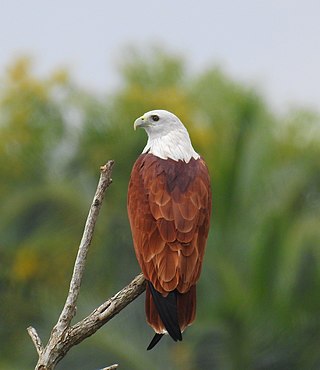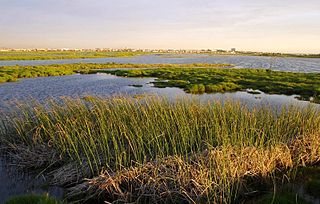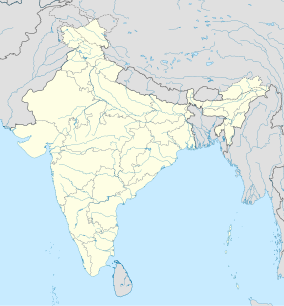
The brahminy kite, formerly known as the red-backed sea-eagle in Australia, is a medium-sized bird of prey in the family Accipitridae, which also includes many other diurnal raptors, such as eagles, buzzards, and harriers. They are found in the Indian subcontinent, Southeast Asia, and Australia. They are found mainly on the coast and in inland wetlands, where they feed on dead fish and other prey. Adults have a reddish-brown body plumage contrasting with their white head and breast which make them easy to distinguish from other birds of prey.

Pulicat Lake is the second largest brackish water lagoon in India,, measuring 759 square kilometres (293 sq mi). Major part of the lagoon comes under Tirupati district of Andhra Pradesh. The lagoon is one of the three important wetlands to attract northeast monsoon rain clouds during the October to December season. The lagoon comprises the following regions, which adds up 759 square kilometres (293 sq mi) according to Andhra Pradesh Forest Department: 1) Pulicat Lake 2) Marshy/Wetland Land Region (AP) 3) Venadu Reserve Forest (AP) 4) Pernadu Reserve Forest (AP) The lagoon was cut across in the middle by the Sriharikota Link Road, which divided the water body into lagoon and marshy land. The lagoon encompasses the Pulicat Lake Bird Sanctuary. The barrier island of Sriharikota separates the lagoon from the Bay of Bengal and is home to the Satish Dhawan Space Centre.

Chilika Lake is a brackish water lagoon, spread over the Puri, Khordha and Ganjam districts of Odisha state on the east coast of India, at the mouth of the Daya River, flowing into the Bay of Bengal, covering an area of over 1,100 square kilometres (420 sq mi). It is the biggest lake of India after Vembanad Lake. This lake is the largest coastal lagoon in India and the largest brackish water lagoon in the world after The New Caledonian barrier reef. It has been listed as a tentative UNESCO World Heritage site. Its salinity varies by region, from nearly freshwater where rivers flow in, to oceanic salinity levels due to tidal influx.

Nal Sarovar Bird Sanctuary, consisting primarily of a 120.82-square-kilometre (46.65 sq mi) lake and ambient marshes, is situated about 64 km to the west of Ahmedabad near Sanand Village, in the Gujarat state of India. Mainly inhabited by migratory birds in winter and spring, it is the largest wetland bird sanctuary in Gujarat, and one of the largest in India. It was declared a bird sanctuary in April 1969.

Vedanthangal Bird Sanctuary is a 30-hectare (74-acre) protected area located in the Madurantakam taluk of the Chengalpattu District in the state of Tamil Nadu, India. The sanctuary is about 75 kilometres (47 mi) from Chennai on National Highway 45 ([NH45]). It is easily reachable from Madurantakam and Chengalpattu. More than 40,000 birds, from various parts of the world visit the sanctuary during the migratory season every year. Vedanthangal is home to migratory birds such as pintail, garganey, grey wagtail, blue-winged teal, common sandpiper and the like. It has been designated as a protected Ramsar site since 2022.

The Kadalundi Bird Sanctuary lies in Vallikunnu Grama Panchayat of Malappuram district in Kerala, India. It spreads over a cluster of islands where the Kadalundipuzha River flows into the Arabian Sea. The Sanctuary hill is around 200 m above sea level. It is located 19 km away from the Kozhikode city centre.

Odisha, a state in eastern India, is extremely diverse and gives the state abundance of natural beauty and wildlife. The districts in the interior are thickly covered by tropical moist deciduous and tropical dry deciduous forests. The hills, plateaus and isolated areas of the northeastern part of the state are covered by the tropical moist deciduous forests whereas the dry deciduous forests are located in the southwest region of the state. Some of the trees which grow in abundance in Odisha are bamboo, teak, rosewood, sal, piasal, sanghvan and haldi. There are 479 species of birds, 86 species of mammals, 19 species of amphibians and 110 species of reptiles present in Odisha. The state is also an important habitat for the endangered olive ridley turtles and Irrawaddy dolphins. Koraput district of southern Odisha has been identified by Food and Agriculture Organisation (FAO) of UN as Global Agricultural Heritage site which is among only other three sites in the world. Other sites are in Peru, China and Philippines.

Odisha, one of the 28 states of India, has two basic kinds of forest: in the northeast region of the state the forest is classified as the tropical-moist-deciduous type, blanketing hills, plateaus and other high-altitude isolated areas; in the southwest the tropical-dry-deciduous variety dominate.

Marievale Bird Sanctuary is a protected area in Gauteng, South Africa. It is about 15 km2 in size, and situated on the East Rand on the southern half of the Blesbokspruit wetland, a Ramsar site. The Blesbokspruit is a major perennial river in Gauteng which is flanked by extensive floodplains on either side. Nearby is the Suikerbosrand Nature Reserve.

The Rietvlei Wetland Reserve is a 663-hectare (1,640-acre) nature reserve situated in Table View, Western Cape, South Africa. It is managed by the City of Cape Town's Environmental Resource Management Department.

Housing more than 200 resident and wintering bird species, Chennai has long been a haven for bird watchers. It is the one of the few urban areas in India with diverse range of birds including greater flamingo, black baza, osprey, Indian eagle-owl, Coppersmith barbet, Spot billed pelican and pied avocet can be seen. The following are some known birding hotspots in and around Chennai.
Mudaliarkuppam Boat House, also known as Raindrop Boat House, is a water sport facility located on the East Coast Road, 36 km to the south of Mamallapuram and 92 km from Chennai in India. It was developed by the Tamil Nadu Tourism Development Corporation on the Odiyur lake back waters. It has rowing, cruising, speed boating, water scooting and kayaking facilities.

Nagi Bird Sanctuary is located in Jhajha Jamui district of south Bihar, near the Jharkhand border. It was declared a bird sanctuary on 25 February 1984 as per Section 18 of the Wildlife (Protection) Act, 1972. The final notification under Section 26A of the act was issued on 4 September 2009. Thousands of migrating birds congregate in the reservoir during the winter season, especially from November to February. The area of the sanctuary is 2.1 square kilometres. It is home to over 133 bird species. There are also a variety of dragonflies, damselflies and butterflies which are yet to be studied and documented. In 2004, Nagi Dam Bird Sanctuary was declared an Important Bird Area (IBA) by BirdLife International. The area overlapping with the IBA is 791 ha.














